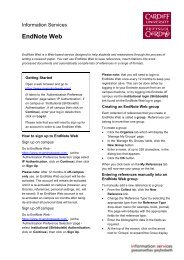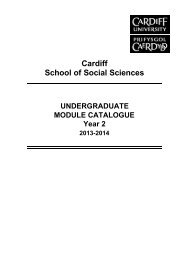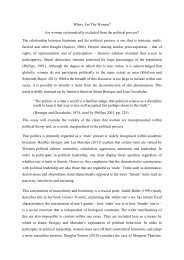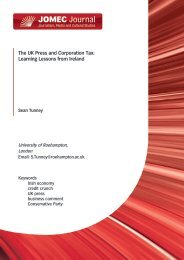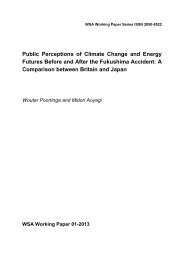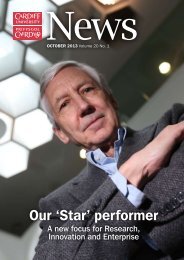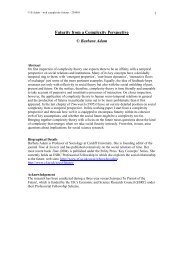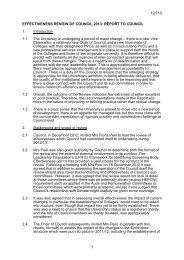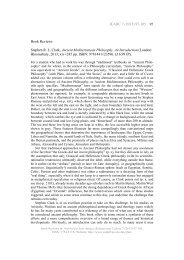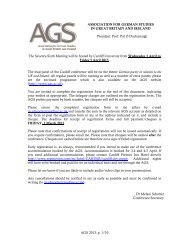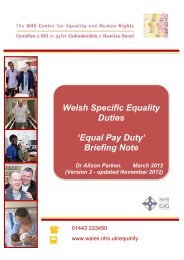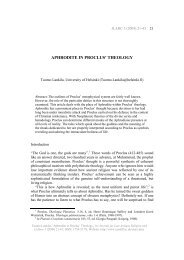Tina Askanius - Cardiff University
Tina Askanius - Cardiff University
Tina Askanius - Cardiff University
Create successful ePaper yourself
Turn your PDF publications into a flip-book with our unique Google optimized e-Paper software.
JOMEC Journal<br />
Journalism, Media and Cultural Studies<br />
Online Video Activism and Political Mash-up Genres<br />
<strong>Tina</strong> <strong>Askanius</strong><br />
Lund <strong>University</strong><br />
Email: tina.askanius@kom.lu.se<br />
Keywords<br />
Video activism<br />
Radical film<br />
YouTube<br />
COP15<br />
Counter-summits<br />
European social forum<br />
Political remix
Abstract<br />
This article situates contemporary forms of video activism in online environments within<br />
a historical trajectory of radical film recruited for Left thinking and action. Focusing on the<br />
remix ethos and aesthetics of political mash-up videos, the article suggests how revisiting<br />
the analogue precursors of digital video may help contextualise and understand new<br />
forms of video activism, and politically committed media practices more generally. In the<br />
first part of the analysis, I engage with some of the principal conceptual themes and<br />
aesthetics that shape the various hybrid genres of the kind of visual activism we see<br />
emerging in YouTube and similar video platforms today. For these purposes, I propose a<br />
typology for understanding the motley array of video documentary and documentation<br />
available online as a hybrid and diverse range of media forms for political investigation<br />
and portrayal. The second part of the analysis demonstrates how such mash-up practices<br />
play out on three distinct levels when digital videos are put in circulation online. First,<br />
political mash-up is understood as a set of material practices in which online content is<br />
mixed and repurposed, second, in terms of a convergence between different styles,<br />
genres and modes of address, and finally, the concept of mash-up opens up for an<br />
understanding of the blurring of boundaries between different political actors and<br />
motives in online media environments.<br />
Contributor Note<br />
<strong>Tina</strong> <strong>Askanius</strong> is a post-doctoral researcher in the Department of Communication and<br />
Media at Lund <strong>University</strong>, Sweden. Her research concerns the relation between media<br />
and political engagement with a particular focus on contemporary forms of video<br />
activism in online environments. Her recent work within this area has been published in<br />
international journals such as Journal of Communication, Journal of E-politics, Interface:<br />
a Journal for and About Social Movements and Research in Social Movements, Conflict &<br />
Change.<br />
cf.ac.uk/jomec/jomecjournal/4-november2013/<strong>Askanius</strong>_Mashups.pdf
Introduction<br />
Convergence, hybridity, and found<br />
footage re-appropriation are defining<br />
features of contemporary online video<br />
activism and political discourse in a<br />
digital age more generally. The practices<br />
of remixing and re-framing moving<br />
images for political purposes have<br />
however been around since the<br />
invention of film. Over time such media<br />
practices have been given many names:<br />
media jamming, détournement, found<br />
footage filmmaking, avant garde film,<br />
television hacking, guerrilla television,<br />
telejusting, political remix, subversive<br />
remix, scratch video and fan vidding,<br />
along with more stagy designations such<br />
as cultural terrorism or cybernetic<br />
guerrilla warfare (McIntosh 2012). The<br />
political use and critical potency of such<br />
remixes is thus not fundamentally new in<br />
itself or confined to the qualities of what<br />
we today understand as new media. The<br />
same applies to the subversive practices<br />
of (illegally) distributing non-licenced<br />
video and film material at the heart of<br />
current controversies over intellectual<br />
property, which have a long history in<br />
Left-leaning communities formed around<br />
the ethical frameworks of remixing and<br />
sharing cassette bands, bootlegging<br />
tapes in underground distribution<br />
channels, community film screenings or<br />
post order mail lists (see e.g., Hilderbrand<br />
2009).<br />
Yet something remarkable and<br />
unprecedented is taking place in terms<br />
of the magnitude of the phenomenon,<br />
the speed by which these memes and<br />
remixes travel online and the motley<br />
range of different actors who engage in<br />
political video practices today.<br />
Contemporary forms of video activism<br />
are increasingly situated within the<br />
market logics of social media and remix<br />
ethos of online user-generated cultures.<br />
www.cf.ac.uk/JOMECjournal<br />
This has profound implications for the<br />
set of longstanding political practices<br />
formed around the ethical frameworks of<br />
watching and sharing tapes and to how<br />
we understand and critically examine<br />
such practices. One arena where these<br />
developments are particularly evident is<br />
YouTube , the world’s largest audio-visual<br />
repository and video-sharing platform.<br />
This article proposes an understanding<br />
of contemporary forms of video activism<br />
as political mash-up genres emerging in<br />
a ‘post-broadcast media ecology’ (Merrin<br />
2008). By situating digital video practices<br />
on YouTube within a historical trajectory<br />
of video activism recruited for Left<br />
thinking and action, the study suggests<br />
how revisiting the analogue precursors of<br />
digital video may help contextualise and<br />
understand contemporary modes of<br />
video activism, and politically committed<br />
media practices more generally.<br />
In the first part of the analysis, I engage<br />
with some of the principal conceptual<br />
themes that shape the various stylistic<br />
genres and aesthetic forms of vernacular<br />
political video we see emerging in<br />
YouTube and similar online environments.<br />
For these purposes, I propose an<br />
exploratory, typological scheme for<br />
understanding them as distinct genres<br />
that, despite their variations, are united<br />
by purpose, practice and to some extent<br />
form. Rather than an exhaustive<br />
inventory, I consider the proposed<br />
typology to be a point of entry into a<br />
broader discussion of how we might<br />
understand these ‘genres’ in relation to<br />
an increasingly complex set of media<br />
flows and circuits of distribution and<br />
consumption across intertwined and<br />
hybrid communication networks<br />
(Chadwick 2013).<br />
The second part of the article further<br />
extends the terms of the analysis by<br />
placing political mash-up genres on<br />
1 <br />
@JOMECjournal
YouTube within the broader history of<br />
amateur video production and DIY<br />
cultures. I argue that contemporary<br />
mash-up practices play out on three<br />
distinct levels of the texts and their<br />
extra-textual circumstance. First, political<br />
mash-up is understood as a set of<br />
material practices in which visuals and<br />
sound are cut and mixed, second, in<br />
terms of a convergence process between<br />
different styles, genres and modes of<br />
address, and finally the concept opens<br />
up for an understanding of the<br />
multiplicity of and blurring of boundaries<br />
between different political actors and<br />
motives in online video activism today.<br />
Unfolding these three facets of the<br />
notion of political mash-up, I link the<br />
history of radical film and video to<br />
contemporary digital practices and<br />
genres. In doing so, a call is made for a<br />
historically grounded conceptualization<br />
of online video activism urging scholars<br />
and media practitioners to ‘reclaim what<br />
happened before YouTube’ (Jenkins<br />
2009: 125).<br />
Methodology and analytical framework<br />
In order to briefly account for the<br />
analytical approach of this analysis of<br />
online video, this section provides an<br />
outline of the body of video material<br />
chosen for analysis and the analytical<br />
strategy applied to the study of YouTube<br />
as both a database for selecting videos<br />
for examination and a research object in<br />
itself.<br />
Empirical material<br />
The videos scrutinized in this analysis<br />
derive from a larger research project on<br />
the radical video practices that emerged<br />
around three different, yet related,<br />
political mobilisations across Europe in<br />
www.cf.ac.uk/JOMECjournal<br />
2008-2009. The project combines textual<br />
analysis of videos with qualitative interviews<br />
and participant observation of the<br />
European Social forum in Malmö,<br />
Sweden in 2008, the alternative COP15<br />
climate summit in Copenhagen in 2009,<br />
and the G20 counter summit in London,<br />
also in 2009 (see <strong>Askanius</strong> 2012). This<br />
article revisits the empirical material<br />
from the three different case studies so<br />
as to detail a taxonomy of the total<br />
population of videos and subsequently<br />
focus on one particular dimension of<br />
these digital remixing practices and<br />
aesthetic forms. The empirical material<br />
consists of a range of different videos<br />
made in the prelude to, during, or in the<br />
aftermath of the three protest events. 1<br />
They are produced by a variety of<br />
different actors, ranging from<br />
independent filmmakers, video<br />
collectives, affinity groups, ephemeral<br />
activist networks and social movement<br />
organisations who all share having<br />
contributed to public discourse with<br />
video documentation and interpretations<br />
of the protests and their political<br />
circumstances on YouTube. In its<br />
capacity as the most dominant arena for<br />
contemporary modes of video activism,<br />
YouTube works both as a database for<br />
selecting videos for analysis and as an<br />
important part of the research object<br />
itself.<br />
1 In order to propose an open-ended and wideranging<br />
typology that captures the broader<br />
context in which the videos of the specific events<br />
are presented and consumed on YouTube, the<br />
sample of videos also includes videos that are<br />
not directly concerned with the three<br />
mobilisations. Such videos may be so called<br />
video responses that reply to videos in the core<br />
sample or videos that have been tagged with<br />
keywords relevant to the three cases (e.g. ESF08,<br />
COP15 or G20 London) so as to direct the viewer<br />
to past and future mobilisations of a similar kind.<br />
2 <br />
@JOMECjournal
Textual analysis and attention to<br />
media form<br />
This study argues for the importance of<br />
close attention to the long history of so<br />
called new media. However, the primary<br />
aim of this article is not to provide a<br />
history of video activism but rather to<br />
examine video texts and their extratextual<br />
circumstances in relation to their<br />
historical contexts. In this manner, the<br />
study is positioned within a tradition of<br />
media studies that gives prevalence to<br />
the analysis of media form and considers<br />
this an important entry point into<br />
understanding the social and political<br />
order of media. Such a tradition is<br />
concerned with issues of power and<br />
commits to the close micro-analysis of<br />
the languages and images of media texts<br />
located within the broader contexts of<br />
social practice and public conduct<br />
(Corner 1995). This analytical strategy<br />
poses questions of the ways in which<br />
prevalent forms of audio-visual<br />
mediation ‘offer ethical positions for<br />
viewers to occupy providing possibilities<br />
for enhanced critical awareness and<br />
favourable conditions for social action’<br />
and provides insights into ‘the virtues of<br />
media representations that may cultivate<br />
(or impinge on) reflexive and active<br />
publics’ (Chouliaraki 2006: 5). I draw on<br />
the work of Corner (2008, 2011) to<br />
establish an understanding of media<br />
form in terms of three overlapping<br />
dynamics: organisation, articulation, and<br />
apprehension. This understanding of<br />
form, carried into the textual analysis of<br />
videos in the YouTube environment has<br />
implications for how attention is focused<br />
on different dimensions of the videos<br />
and the platform in which they<br />
proliferate. It becomes possible to extend<br />
the scope of the analysis beyond<br />
questions of what is depicted on screen<br />
so as also to induce analytical<br />
susceptibility in the various dynamics of<br />
viewers’ engagement with the videos. In<br />
this manner, considering form as a<br />
three-dimensional concept reflects the<br />
various (often overlapping) ways of<br />
approaching the object of analysis as<br />
both video texts (their aesthetic qualities<br />
and protocols of argument) and their<br />
extra-textual circumstances (how they<br />
are presented online, shared, liked,<br />
‘favorited’, commented upon etc.).<br />
Contextualising radical filmmaking: the<br />
historical roots of online video<br />
activism<br />
Online video activism should be<br />
understood in relation to a long history<br />
of political practices and traditions of<br />
scholarly attention towards these<br />
practices. The prefixes ‘alternative’,<br />
‘radical’, ‘progressive’ etc. variously put in<br />
front of ‘video’ to designate largely Leftleaning<br />
filmmaking signal a commitment<br />
to political action and social change. As<br />
a rebuttal to dominant mainstream<br />
(mis)representations of political protests<br />
and movements, video activism is<br />
defined by a commitment to explain<br />
‘what people are protesting’ in ways that<br />
project an alternative image, especially of<br />
non-violent disobedience, and in doing<br />
so draw on a critical, political and<br />
aesthetic vocabulary largely absent in<br />
dominant culture (Juhasz 1995: 32).<br />
Juhasz (1995) argues that significant<br />
productions of political filmmaking occur<br />
when rapid changes in politics, theory<br />
and technology align. Historically,<br />
politically committed video can thus be<br />
traced through a number of film and<br />
video movements rooted in the political<br />
struggle for representation and voice. In<br />
a Western context, the American<br />
underground cinema of the 1950s and<br />
early 1960s can be seen as a direct<br />
precursor to the radical protest cinema<br />
3 <br />
www.cf.ac.uk/JOMECjournal<br />
@JOMECjournal
of the 1960s and 1970s, which<br />
documented the political activism of civil<br />
rights, anti-colonialism, anti-war protests,<br />
women and gay liberation movements<br />
(Boyle 1997; Juhasz 1995). Since the<br />
1970s a great deal of theoretical work,<br />
as well as filmmaking practice on the<br />
Left, has been devoted to developing and<br />
analysing ‘a revolutionary aesthetics – a<br />
combative form that poses the right<br />
questions in the intellectual struggle<br />
against capitalism’ (Gaines 1999: 232).<br />
Throughout the 1980s and 1990s antisystemic<br />
and critical voices continued to<br />
tap into the possibilities offered by video<br />
as the equipment and editing tools<br />
slowly became better and cheaper.<br />
Important examples of such upsurges in<br />
politically motivated video and television<br />
production include the bulk of alternative<br />
public access television projects<br />
launched in the early 1980s, also known<br />
as the guerrilla television movement (see<br />
e.g., Boyle 1997; Halleck 2005; Kellner<br />
1990; Stein 2001) or the anti-roads<br />
movement in Britain (Harding 2001),<br />
which used video to combine<br />
environmental activism with anticapitalist<br />
critique and critical<br />
perspectives on sustainable development<br />
– concerns that run into the global<br />
climate change activism that so urgently<br />
demands our attention today.<br />
The 2008 meltdown of financial markets<br />
provoked an upsurge in subversive video<br />
work and a renewed incitement to<br />
contest global capitalism and the<br />
increasing hegemony of market values in<br />
all aspects of governance in liberal<br />
democracies. But we need to go back<br />
another decade to the first countersummits<br />
and mass-demonstrations of<br />
the alter-globalisation movement against<br />
corporate power and financial<br />
globalisation in the late 1990s to fully<br />
understand the trajectory of<br />
contemporary protest politics. Largescale<br />
demonstrations against the<br />
institutions and symbols of global<br />
capitalism and the efforts to<br />
contemplate, mobilise for, document and<br />
raise awareness of these decentralised,<br />
but ‘spectacular’ protest events were part<br />
of what brought about the rapid growth<br />
of video activism in the late 1990s<br />
(Harding 2001). These political issues<br />
rose to the broader public agenda right<br />
around the time of the shift from<br />
analogue to digital video. The threshold<br />
of storage, processing capacity, and<br />
bandwidth we crossed in the mid-2000s,<br />
not only opened up new possibilities for<br />
dedicated ‘vidders’ and radical<br />
documentary makers but also catapulted<br />
political video into mainstream<br />
consciousness and everyday media<br />
practices (Russo and Coppa 2012).<br />
In the past decade, the struggle to<br />
contest neoliberalism and expose its<br />
consequences has been enacted in<br />
video production and theory, and<br />
inspired a large body of video work<br />
questioning the structure of institutions<br />
such as G8/20, The IMF, the WTO,<br />
corporate power, the politics of third<br />
world debt and the uneven distribution<br />
of power and resources in the process of<br />
financial globalisation. The waves of<br />
protests that currently face liberal<br />
democracies in the wake of the<br />
implosion of global markets grow out of<br />
this same matrix and a systemic critique<br />
similar to that of the alter-globalisation<br />
movement are raised today by the 15-M<br />
Indignados, the Occupy movement and<br />
the widespread austerity mobilisations<br />
across Europe. Although these<br />
movements have very different compositions,<br />
strategies and to some extent<br />
political orientations, they are united by<br />
how they contest the neoliberal<br />
mechanism by which all aspects of<br />
political and social organisation are<br />
increasingly based around the primacy<br />
4 <br />
www.cf.ac.uk/JOMECjournal<br />
@JOMECjournal
of unregulated markets and economic<br />
growth. 2<br />
In the following, I suggest that the motley<br />
body of political video and filmmaking<br />
concerned with the social, political and<br />
environmental consequences of neoliberalism,<br />
understood as both a regulatory<br />
force, political rationale and mode of<br />
governmentality, inscribes itself into this<br />
trajectory of intellectual and political<br />
movements that draw heavily on visual<br />
media in their struggle for voice and<br />
representation. The new generation of<br />
online video activists are thus (more or<br />
less knowingly) furthering a timehonoured<br />
tradition with roots in this<br />
prismatic array of experimental and<br />
alternative media movements (Gregory et<br />
al. 2005). While television, historically, has<br />
been considered the most challenging<br />
medium to reconstruct in an alternative<br />
mode because of the high costs of<br />
production and distribution (Hands<br />
2009), the development of internetenabled<br />
video in conjunction with lowcost,<br />
or even free editing tools have<br />
made video- production, remixing and<br />
commentary literally for everyone. This<br />
‘democratisation’ 3 requires us to look<br />
closer at the diverse nature of politically<br />
motivated video currently in circulation<br />
and at how these digital genres are<br />
reminiscent of their analogue precursors<br />
2<br />
For an extensive analysis of the lines of<br />
continuity between the alter-globalisation<br />
protests of the 1990ies/early 2000s and the<br />
recent wave of political mobilisations in the<br />
Occupy movement and beyond, see Fominaya<br />
and Cox (2013).<br />
3 Democratisation is put in brackets to indicate<br />
the ambiguity of such a claim. The inherent<br />
promise of YouTube as a democratic platform<br />
from which everyone can raise their voice and<br />
broadcast themselves is obviously undercut by<br />
the realities of commercial interests and<br />
censorship that saturate the social media<br />
industry today.<br />
www.cf.ac.uk/JOMECjournal<br />
but may also bring essentially new<br />
qualities into the mix.<br />
‘New’ forms of video activism rooted in<br />
‘old’ political struggles<br />
As a first analytical effort, I start by<br />
offering a typology of the prismatic body<br />
of different videos mobilising for,<br />
reporting from, and reflecting upon the<br />
three political mobilisations across<br />
Europe and anti-capitalist struggles more<br />
generally. These include the mobilisation<br />
video, the witness video, the documentation<br />
video, the archived radical video<br />
remediating historical work and finally,<br />
the political mash-up video. By detailing<br />
five broad-brushed types of radical<br />
online video, I provide a framework to<br />
contextualise the analytical efforts of the<br />
second section, in which I turn to a more<br />
detailed analysis of the political mash-up<br />
as a particularly prevalent category of<br />
video recruited for Left wing thinking and<br />
action today. Needless to say, this is no<br />
exhaustive categorisation. Not only would<br />
such an undertaking be relatively<br />
useless, it is also not possible to make<br />
any empirical generalisations about<br />
universal patterns and categories on the<br />
basis of the empirical material. These are<br />
hybrid genres within a chaotic and<br />
staggeringly abundant sea of online<br />
videos. Hence, in the proposed typology, I<br />
engage with some, but not all, of the<br />
different forms of politically committed<br />
video one can encounter on YouTube<br />
today.<br />
Mobilisation videos<br />
The term mobilisation video is used, by<br />
practitioners and activists, to refer to the<br />
short videos disseminated prior to a prescheduled<br />
demonstration or direct<br />
action event (for a few examples of this<br />
5 <br />
@JOMECjournal
genre see appendix 1-4). Other labels<br />
used to describe this mode of video are<br />
‘protest trailers’, ‘demo-teasers’, protest<br />
promos’, ‘call out videos’, or ‘riot porn’.<br />
Explicitly calling for political action, the<br />
mobilisation video urges viewers to take<br />
action by joining a protest in the streets,<br />
or to engage online by further spreading<br />
the call for action in personal networks.<br />
These are short, piecemeal, bite-sized<br />
slogans most often adapted to the time<br />
frame of a television advertisement. As a<br />
flexible genre, guiding rather than<br />
determining styles and strategies,<br />
mobilisation videos follow a set of shared<br />
dramaturgic rules. They bring together<br />
discursive resources and historical<br />
genres to stage injustice as a spectacle<br />
that requires action and set up a given<br />
space of action for the viewer. This is<br />
often done by drawing upon footage and<br />
photographs from previous demonstrations<br />
and actions that are reappropriated<br />
and given new meaning in<br />
new calls for action. Mobilisation videos<br />
end with concrete directions for how to<br />
act upon what is witnessed on screen,<br />
usually by providing a link to a website<br />
where the viewer can get additional,<br />
more detailed information on the<br />
promoted event (see fig. 1).<br />
Figure 1. Pay-off in a mobilisation video for<br />
the ESF2008 (see appendix 1)<br />
Characterised by a stark visual contrast<br />
between evil-doers and benefactors, a<br />
problem and its solution, the condensed<br />
narrative of the mobilisation video seeks<br />
www.cf.ac.uk/JOMECjournal<br />
to reduce complex political issues to a<br />
feasible space of action. The story told in<br />
order to ‘rally the troops’ (Gregory et al.<br />
2005: 10) obviously differs from<br />
mobilisation videos intended for a<br />
broader audience of non-activists. A<br />
fruitful distinction can therefore be made<br />
within this genre between the videos, reeducating<br />
and re-solidifying solidarity<br />
among the already converted, and the<br />
videos used to ‘initiate, convert or recruit<br />
new adherers’ (Gaines 2007: 87). Yet<br />
another useful notion for understanding<br />
the dramaturgy of these calls for action<br />
is the idea of ‘body genres’ used to<br />
describe the commonalities of works<br />
that make us want to do something and<br />
are designed for the ‘production of<br />
outrage’ to galvanize ‘body works’ (Gaines<br />
2007). In an online context, ‘body genres’<br />
aim to physically move the body of the<br />
spectator away from the screen into the<br />
street.<br />
Witness videos<br />
The witness video is a label used to<br />
designate videos documenting specific<br />
unjust conditions or political wrongdoings/doers,<br />
police brutality, human<br />
rights violations etc. These caught-oncamera<br />
snapshots are often recorded on<br />
mobile cell phones and uploaded<br />
without much editing (for an example,<br />
see appendix 5). While these videos<br />
dominantly apply strategies of realism,<br />
using the bumpy handheld aesthetic to<br />
induce authenticity and a sense of ‘being<br />
there’, others rely on more performative<br />
strategies, setting the footage to music<br />
and adding on-screen graphics, voiceover<br />
or text. In these videos, the space of<br />
action is often implied rather than<br />
explicated (as opposed to the<br />
mobilisation videos that provide much<br />
more explicit directions for action).<br />
Chanan (2011) dubs this kind of video<br />
6 <br />
@JOMECjournal
‘citizen reportage’, to signal how ordinary<br />
citizens (non-activists) increasingly<br />
engage in video documentation that<br />
stands out, not for technical or aesthetic<br />
proficiency, but for its sense of<br />
participation in audio-visual immediacy<br />
(Chanan 2011: 220). Critical to this genre<br />
is the sense of the presence of the<br />
person recording the video (Chanan<br />
2011: 222). Often the videographer’s<br />
voice (or cry) as she react to what is<br />
witnessed is present and forms part of<br />
the power of the message that comes<br />
across. Variations of the witness video<br />
also include follow-up interviews with<br />
activists providing eyewitness accounts<br />
recorded in the aftermath of the protests<br />
e.g. to counter mass media’s framing of<br />
the events. Videos such as the amateur<br />
studio interviews produced by Indymedia<br />
providing alternative eyewitness<br />
accounts of the death of Ian Tomlinson<br />
during the G20 protests in London fall<br />
under this category (see appendix 6).<br />
Documentation videos<br />
Documentation videos make up the body<br />
of videos that, in a simple and<br />
straightforward manner, document<br />
activist marches, speeches, community<br />
meetings, direct actions, political<br />
happenings etc. This cluster of selfdocumentation<br />
works mainly as modes<br />
of auto-communication and reflects the<br />
role of video in forging collective identity,<br />
a sense of belonging, community and<br />
sustained commitment. Examples<br />
include videos documenting the People’s<br />
Assembly during the COP 15 (see<br />
appendix 7) or the work of feminist<br />
collective FemFokus who try to capture<br />
the collective atmosphere of the<br />
ESF2008 while documenting the various<br />
political happenings around the city of<br />
Malmö during the social forum (see<br />
appendix 8). In a recent study of the use<br />
www.cf.ac.uk/JOMECjournal<br />
of YouTube by London-based social<br />
movement organisations, the author<br />
finds that ‘members use online spaces<br />
as visual archives of their offline activities<br />
and personal ties’, indicating how ‘photos<br />
from offline events can help sustain<br />
commitment to the group by providing<br />
group members with possibilities for<br />
viewing documentation from their own<br />
participation’ (Uldam 2010: 312). For<br />
these purposes, YouTube works as a<br />
cultural archive for offline activities<br />
forming a place of memory that fosters<br />
commitment to the act of participation<br />
(Carpentier 2010). Here we might also<br />
situate the longer video items that have<br />
sprung up recently in connection with<br />
the wave of occupied campuses and<br />
public spaces seized by activists in the<br />
Occupy movement, for example in<br />
London. Featuring the talks of supportive<br />
academics and writers such as Graeme<br />
Turner, Judith Butler or David Harvey<br />
visiting the protest camps, these videos<br />
are strongly reminiscent of what in the<br />
1960s was dubbed the ‘teach-in’<br />
(Chanan 2011). Other examples include<br />
the videos documenting the speeches of<br />
activist academics such as Naomi Klein<br />
at the alternative climate summit<br />
‘Klimaforum09’ in Copenhagen or the<br />
talk of Michael Hardt at the ESF in<br />
Malmö 2008 (see appendices 9 and 10).<br />
Archived radical video<br />
YouTube is also a space in which the<br />
digitised 16mm and 8mm film of<br />
historical video collectives are<br />
remediated so as to (potentially) bring<br />
new life and a new audience to these<br />
works. With a para-text or on-screen text<br />
presenting and contextualising the video<br />
for a present day audience, videos from<br />
historical Left-wing collectives such as<br />
7 <br />
@JOMECjournal
TVTV, 4 Deep Dish and DIVA TV 5<br />
documenting the ACT UP (The AIDS<br />
Coalition To Unleash Power) protests of<br />
the late 1980s are presented next to<br />
recently uploaded videos of the Occupy<br />
Wall Street demonstrations and videos<br />
discussing the role of social media in the<br />
Arab spring (See fig. 2).<br />
Figure 2. YouTube search result connecting<br />
struggles across time and space<br />
Other examples of this archival mode of<br />
video include the body of video work on<br />
the YouTube channel of Third World<br />
Newsreel (TWN). The activist filmmaker<br />
collective TWN has worked with video<br />
and documentary to promote selfrepresentations<br />
of ethnic minorities,<br />
LGBT and other traditionally marginalised<br />
groups since 1967 (For an analysis of<br />
early Left-wing newsreels see e.g. Nichols<br />
1973, Renov 1987). The TWN YouTube<br />
channel contains a rich archive of videos<br />
connecting social justice struggles<br />
across a timespan of nearly five decades<br />
(see appendix 11). Although far from all<br />
historical radical video and documentary<br />
have been digitized or necessarily<br />
archived on YouTube only, these videos<br />
represent an important category in so far<br />
4 TVTV is short for Top Value Television: a San<br />
Francisco-based video collective founded in<br />
1972. See appendix 12 for an example of how<br />
TVTV’s pioneering alternative news report from<br />
the 1972 Republican National Convention recirculates<br />
on YouTube today.<br />
5 The acronym DIVA is short for ‘damn interfering<br />
video activists’, a collective of video makers in<br />
New York spawned by the AIDS crisis (see<br />
appendix 13).<br />
www.cf.ac.uk/JOMECjournal<br />
as they demonstrate how YouTube<br />
provides a space in which new and old<br />
videos, raising similar political issues, are<br />
presented to the viewer in an intertextual<br />
web that may potentially connect past<br />
and present struggles.<br />
Political mash-ups<br />
The fifth and final subgenre of videos that<br />
I want to draw attention to is that of the<br />
political mash-up. Whereas the<br />
preceding category consisted of archived<br />
video work, this mode of video concerns<br />
itself with ‘contemporaneous archival<br />
interventions’ (Horwatt 2009). This broad<br />
category of videos is seen to designate<br />
the amalgamation of multiple source<br />
materials that are montaged together to<br />
construct a political argument. This can<br />
encompass mixing raw amateur footage<br />
or video diary recordings (the talking<br />
head) with snippets of found footage:<br />
news reports, music videos, motion<br />
pictures, entertainment programs,<br />
cartoons, animations, commercials or<br />
other bits and pieces from the<br />
inexhaustible pool of ‘semiotic resources’<br />
made available online (Kuhn 2012). The<br />
political mash-up video epitomises the<br />
hybridity and inter-mediality found at the<br />
intersection point between the very<br />
purposeful and serious political<br />
statements on the one hand and the<br />
playful ‘everyday creativity’ (Gauntlett<br />
2011) of increasingly media literate<br />
citizens, on the other. On YouTube , these<br />
videos are located within a conceptual<br />
grey zone and ambiguous space of<br />
media production where amateurs meet<br />
professionals, anti-capitalism meets<br />
corporate control, and the mundane<br />
politics of everyday life meets militant<br />
activism. In the following section, I unfold<br />
the aesthetic qualities and historical<br />
roots of this final category in greater<br />
detail.<br />
8 <br />
@JOMECjournal
Political mash-up videos: Mixing<br />
content, genres and modes of<br />
politicality<br />
In a sense, all of the videos described<br />
and categorised above are products of<br />
different strategies of remixing and reappropriation.<br />
The mobilisation video<br />
often appropriates footage of previous<br />
mobilisations and recycles iconic images<br />
of past political struggles to galvanize for<br />
new protests. Similarly, the digitized<br />
editions of old 16 or 8mm films and VHS<br />
cassettes described in the fourth<br />
category are often sampled with, for<br />
example, graphics, text boxes, animated<br />
speech bubbles so as to re-appropriate<br />
the video for a contemporary audience.<br />
Yet this final category stands out for the<br />
extent to which the videos draw on preexisting<br />
material in a remixing process<br />
that operates on several levels of<br />
abstraction, three of which I will highlight<br />
here.<br />
Edwards and Tryon (2009) define mashups<br />
as videos that ‘recombine two or<br />
more pre-existing videos and/or audio<br />
sources into a new, derivative work’. In a<br />
similar vein, Chanan speaks of political<br />
remix videos, which take found material<br />
from multiple sources and recombine it<br />
in new ways (2011: 220). In McIntosh’s<br />
(2012) account of a historical body of<br />
subversive video remixes made between<br />
WWII and the launch of YouTube, he<br />
defines the genre in relation to five<br />
shared characteristics: For one thing,<br />
they work to appropriate mass media<br />
material without copyright permissions.<br />
They comment on, deconstruct or<br />
challenge media narratives, dominant<br />
myths, social norms and traditional<br />
power structures. They transform the<br />
original message embedded in the<br />
source material. Further, such videos are<br />
indented for amateur and DIY<br />
communities rather than elites,<br />
academic or high art audiences. Finally,<br />
they are low-end productions and rely<br />
on grassroots circuits of distribution. In<br />
previous periods, the distribution of such<br />
videos took place in VHS duplicating<br />
circles, film screenings, later in selfhosted<br />
websites such as Guerrilla News<br />
Networks or Adbusters, and after 2005<br />
primarily through YouTube (McIntosh<br />
2012).<br />
Today, political mash-ups are ‘a YouTube<br />
staple’ (Russo and Coppa 2012). The<br />
genre predates YouTube by more than 60<br />
years, however. A very early example is<br />
the short propaganda film ‘The Lambeth<br />
Walk-Nazi Style’ produced and circulated<br />
by the British Ministry of Information in<br />
1942. The re-edit, which mocked the<br />
German Army, was distributed uncredited<br />
to newsreel companies in the US and UK<br />
and is generally regarded as one of the<br />
first political mash-up videos. In fact, the<br />
tradition can be traced even further back<br />
to the 1920s when Russian re-editors<br />
would repurpose American Hollywood<br />
films to create Marxist narratives and<br />
class messages. These early re-mixes<br />
were painstakingly done by hand, splicing<br />
strips of film and setting them to a new<br />
audio track (McIntosh 2012). The 1980s<br />
and 1990s brought videotapes and home<br />
VCRs allowing artists, activists and fanvidders<br />
to make remixes via tape-to-tape<br />
editing. Although history is filled with<br />
analogue precursors to digital video of<br />
this sort, it would seem that the digital<br />
qualities and online circulation is bringing<br />
something essentially new to the<br />
practices and aesthetics of political<br />
mash-up. Therefore, in order to fully<br />
understand what the phenomenon<br />
entails today in an era of digital media, I<br />
want to extend the notion of political<br />
mash-up beyond the material practices<br />
of remixing to signify a process which<br />
unfolds on three different levels.<br />
9 <br />
www.cf.ac.uk/JOMECjournal<br />
@JOMECjournal
Contemporary forms of video activism -<br />
within which political mash-up videos<br />
represent a particular prevalent mode of<br />
creating a political argument – are about<br />
a mix of not only new and found material<br />
but of genres, actors and different<br />
degrees of political intentionality. Let me<br />
briefly unfold this argument by detailing<br />
the three interrelated dimensions of<br />
political mash-up at the level of both<br />
form (textual) and practice (extra textual)<br />
and in doing so, focus on some of the<br />
tensions and dualities that emerge in<br />
this process.<br />
The material practices of political<br />
mash-up<br />
First, I consider the concept of political<br />
mash-up to refer to the remix of new<br />
and found video material to advance<br />
‘new political narratives and promote<br />
political subtexts’ (Edwards and Tryon<br />
2009). At this level, mash-up video<br />
makers engage in the critical<br />
transformation of media content. A large<br />
body of theory has been devoted to<br />
remix at this level (see e.g. Edward 2009;<br />
Kuhn 2012; Horwatt 2009; McIntosh<br />
2009; 2012). The various ways users cocreate<br />
online content have been<br />
described interchangeably as e.g.<br />
mediated modes of ‘DIY citizenship’<br />
(Hartley 2010) or acts of ‘photoshopping<br />
for democracy’ (Jenkins 2006). As a set<br />
of material practices, political mash-ups<br />
that document and narrate demonstrations<br />
and political struggles, involve<br />
the process of cutting and mixing digital<br />
content. Juxtaposing new and archived<br />
content, the videos are testimony to how<br />
‘critical digital intertextuality’ (Edwards<br />
and Tryon 2009) works to visually<br />
connect past and present struggles<br />
across time. Today, such videos are<br />
distributed simultaneously or in close<br />
proximity to the event they recount and<br />
www.cf.ac.uk/JOMECjournal<br />
are characterised by an evanescence<br />
and overabundance of ephemeral<br />
images. Some of their defining features<br />
thus include the speed with which they<br />
circulate, the fluid and ephemeral quality<br />
of their existence, and the collaborative<br />
nature of how they are made by tearing<br />
apart and putting together material from<br />
the vast sea of images made available<br />
online.<br />
Within all of the earlier traditions of<br />
political filmmaking and movements<br />
described in the previous sections, remix<br />
and the purposeful re-appropriation of<br />
existing footage have been key<br />
components in historical political<br />
struggles as part of the subversive fabric<br />
of their messages. Despite such<br />
continuities over time, Horwatt (2009)<br />
points out that whereas remixers in the<br />
past relied mainly on B-films and film<br />
waste (because of the inaccessibility or<br />
high price of original footage), political<br />
remixers today have unlimited access<br />
(although illegally) to any thinkable kind<br />
of mainstream media content. This<br />
inevitably changes and extends the<br />
discursive-aesthetic range of resources<br />
from which remix arguments can be<br />
built.<br />
One prevalent mode of remixing content<br />
in political mash-up videos is to<br />
juxtapose images with a soundtrack and<br />
lyrics that re-narrates and re-casts the<br />
images into new contexts of meaning.<br />
Such audio-remixing strategies are by<br />
way of example demonstrated in the<br />
video ‘All together now Genoa G8’ in<br />
which gory images of the brutal violence<br />
of the Italian police during the G8<br />
summit in Genoa 2001 is set to the<br />
joyful and carefree tones of a Beatles<br />
love song creating a satiric and<br />
dissonant political statement on protest<br />
policing and repressive authorities in<br />
liberal democracies (see appendix 14).<br />
10 <br />
@JOMECjournal
genres and products. They hardly<br />
represent a self-contained or stable<br />
genre. Instead, they migrate, mutate,<br />
replicate in a constant shuttle between<br />
fictional and factual genres in a ‘cross<br />
pollination of styles’ (Hill 2007).<br />
Figure 3. Framing the news anchor as<br />
croupier in the absurd theatre of casino<br />
capitalism.<br />
Another example of the critical and<br />
playful remixing of content characteristic<br />
of the political mash-up video is seen in<br />
the Indymedia production ‘Pro Capitalists<br />
gather for G20 in London April 1st’. In<br />
this video, scraps of CNN, BBC, RT and<br />
FOX news reports on the global financial<br />
crisis are ‘jammed’ so as to ridicule and<br />
subvert the statements of politicians,<br />
bankers and news anchors.<br />
Mixing these ‘disrupted’ news reports<br />
with amateur recordings from anticapitalist<br />
protests in London and footage<br />
from a Casino, this hodgepodge of reedited<br />
content frames the global<br />
financial crisis as a product of ‘casino<br />
capitalism’, the corruption of political<br />
and economic world leaders, and the<br />
inability/reluctance of mainstream<br />
media to critically probe and expose<br />
these matters to the public (see<br />
appendix 15).<br />
A particularly good example of videos<br />
that work between performative and<br />
realist strategies to attract the attention<br />
of the viewer are mash-up videos, which<br />
combine the features of the personal<br />
vlogs with what we may loosely refer to<br />
as the alternative news report. In<br />
collapsing these two genres, such videos<br />
for instance combine close-ups of ‘the<br />
talking head’ typical of the video diary,<br />
with eyewitness accounts or fragments<br />
of mainstream media news material, to<br />
create a new and personalised narrative<br />
of the protest event. Some of these more<br />
individualised modes of political<br />
expression intrinsic to the video diary<br />
tend to deflate into a politics of<br />
narcissism in videos that seem to be is<br />
more about boosting channel traffic and<br />
achieving celebrity vlogger status than<br />
about constructing a political argument<br />
or engaging in political a debate.<br />
The collapse of genres and styles<br />
Second, the concept of mash-up also<br />
bears meaning to the process of mixing<br />
genres and stylistic forms. Political<br />
mash-up videos draw upon a wide range<br />
of different discourses, styles, and<br />
narrative structures of different media<br />
www.cf.ac.uk/JOMECjournal<br />
Figure 4. Crossover between the intimate<br />
video diary and the alternative news report.<br />
We see these tensions being played out<br />
in the video ‘Goodbye Alex’ in which a<br />
vlogger pays tribute to the Greek<br />
teenager, Alexandros Grigoropoulos,<br />
killed by police in Athens in 2008 (see<br />
appendix 16). On YouTube his death<br />
spawned a surge of alterative news<br />
11 <br />
@JOMECjournal
eports and commemoration videos that<br />
link his death to anti-capitalist struggles<br />
across Europe and a broader critique of<br />
the marriage between state repression<br />
and neoliberalism in Western<br />
democracies. In ‘Goodbye Alex’ the<br />
female vlogger pose as news anchor and<br />
commentator in a subjective and<br />
sexualised performance that weaves the<br />
story of his death and the following riots<br />
across Greece into a de-politicised<br />
narrative of everyday life and the<br />
hardships of being a teenager. Placed in<br />
a bedroom setting and addressing the<br />
camera in a confessional mode, the<br />
video combines eyewitness accounts of<br />
the events leading to his death (cell<br />
phone recordings taken from a nearby<br />
balcony), and images of the ensuing riots<br />
with broadcast news images from the<br />
funeral. Used as a platform to stage<br />
herself and the vlog, the video<br />
encapsulates how political mash-up<br />
videos are situated in the grey zones<br />
between documenting a story and<br />
creating a new one in a process which,<br />
in some cases, is less about mobilising<br />
solidarity than it is about forging ‘a public<br />
experience of self’ (McDonald 2002: 125).<br />
Edwards (2009) argues that as opposed<br />
to earlier modes of video activism that<br />
sought to signal their difference from<br />
mainstream, dominant media forms,<br />
political mash-up video today ‘embraces<br />
popular culture as its starting point’. This<br />
new quality to some extent collides with<br />
how the political use of video,<br />
traditionally, has been strongly<br />
connected to the production and<br />
submission of visual evidence. The<br />
videos on the one hand build their<br />
arguments around truth claims and<br />
ambitions to expose ‘the real’ version of<br />
the events. On the other hand, in the<br />
process of ‘jamming’ the footage and<br />
recombining it in new ways, they<br />
produce polysemous and ambiguous<br />
www.cf.ac.uk/JOMECjournal<br />
readings and dramatize the event at the<br />
expense of facts and the strict<br />
submission of visual evidence. The<br />
blurred, shaky footage induces a sense<br />
of immediacy and the lack of<br />
professional sheen adds to a feeling of<br />
authenticity. At the same time, digitally<br />
manipulated images are ubiquitous in<br />
the videos and the digital animations<br />
added onto the footage dislocate the<br />
realist strategies of the handheld camera<br />
position. Certainly, the playful and<br />
performative nature of certain videos and<br />
the popular cultural contexts from which<br />
the material is lifted can undercut claims<br />
of alterity and the radicality of<br />
documenting political realities that<br />
require action. As testimonies to the<br />
cross-fertilization, mimicry, and<br />
hybridisation so central to political<br />
discourse in a digital age, these videos<br />
straddle the categories of fact and<br />
fiction, art and document, entertainment<br />
and information, politics and popular<br />
culture. In doing so, they blur the<br />
boundaries between authenticity and<br />
performativity, subject and celebrity,<br />
individualism and collectivity.<br />
The convergence of political actors<br />
and motives<br />
Finally, the concept of mash-up should<br />
also be understood in relation to the<br />
many different actors, more or less<br />
overtly political in intent and modes of<br />
address, who engage in video activism<br />
today. The remix culture of today is not<br />
confined to the few who have access to<br />
technology and the skills to master the<br />
equipment. Today, virtually anyone with a<br />
laptop and an internet connection can<br />
make a mash-up video within a matter<br />
of minutes. This vague category of<br />
‘anyone’ is also part of what requires us<br />
to rethink what we understand by the<br />
notion of political mash-up videos and<br />
12 <br />
@JOMECjournal
video activism more broadly. Although<br />
this does not imply that anyone with a<br />
mobile phone camera has become a<br />
video activist, the opening up of the field<br />
of video activism does make traditional<br />
conceptualisations and strict boundaries<br />
hard to sustain. The role of the video<br />
activist is taken up by an increasingly<br />
broad range of different, not always<br />
easily identifiable or explicitly political,<br />
actors. On YouTube this development is<br />
epitomised by how the work of, for<br />
example, established video monitoring<br />
groups documenting police brutality and<br />
independent radical filmmakers are<br />
chaotically sandwiched together with<br />
those of unaffiliated, more or less<br />
politically motivated passers-by who,<br />
perhaps even by chance, have caught a<br />
pivotal incident on camera. At this extratextual<br />
level of the process of mash-up,<br />
technology has not only brought a new<br />
group of actors into the field, but has<br />
also brought this motley array of different<br />
actors in contact on some platforms. On<br />
the one hand, the same videos display<br />
Left propagandist-realism reverberating<br />
with the politics of traditional class<br />
struggle against unjust social conditions,<br />
providing a collective response and<br />
directions for how to change these<br />
conditions together. On the other hand,<br />
the example of ‘Goodbye Alex’ described<br />
above illustrates how these ideological<br />
horizons are often combined (and<br />
sometimes clash) with vernacular, popculture<br />
remixes and more individualistic<br />
modes of political expression and<br />
identity politics.<br />
In this sense, the notion of mash-up is<br />
concerned with how videos are made by<br />
and blur the boundaries between<br />
different actors who all display different<br />
modes of ‘politicality’ (Corner 2011). This<br />
notion of politicality refers to the different<br />
levels and ‘aspects of being political and<br />
doing politics’ in (textual) and around<br />
www.cf.ac.uk/JOMECjournal<br />
(extra-textual) the videos. Surely, video<br />
activism is defined by the explicit<br />
engagement with and critique of ‘issues<br />
to do with the control of resources and<br />
exercising of social power through<br />
formal institutions and procedures of<br />
regulation’ (Corner 2011: 189). Across the<br />
broad spectrum of videos that fall into<br />
this category however, some showcase<br />
groups that are actively campaigning for<br />
more participation within an extended<br />
democracy, while others depict groups,<br />
networks and individuals that are<br />
carrying out self-conscious ‘guerrilla’<br />
actions against a system about whose<br />
possibilities for change they remain<br />
pessimistic. At the level of text, the<br />
videos are, on the one hand, defined by<br />
their very explicit, directed and selfconscious<br />
engagement with core<br />
political issues unfolding on screen. On<br />
the other hand, the various modes of<br />
appropriating these videos online such<br />
as sharing, liking, ‘favouriting’, ‘digging’,<br />
commenting or remixing can<br />
demonstrate different and less overtly<br />
political modes of engagement by<br />
different actors driven by a multiple<br />
range of motives. These extra-textual<br />
modes of politicality could be<br />
understood as more subtle ways of<br />
engaging with politics, which may only<br />
implicitly critique institutions and<br />
structures of power. Conversely, other<br />
videos that are not necessarily directed<br />
at a specific, opinionated community of<br />
viewers, may be received by an online<br />
audience in a highly politicised manner<br />
and spur extensive political debate. In<br />
this sense, the videos work concurrently<br />
to both deliver the political as a set of<br />
participatory practices directly attacking<br />
and intentionally seeking to affect the<br />
formal institutions of power, and to bring<br />
out a sense of political engagement that<br />
demonstrate the broader manifestations<br />
of politicality, i.e. the multiple ways of<br />
‘being political’ and performing politics<br />
13 <br />
@JOMECjournal
which can materialise in numerous,<br />
often unforeseen (and sometimes even<br />
unintended), ways across the cultural<br />
terrain.<br />
Political mash-ups are a departure from<br />
earlier modes of media activism, but not<br />
all are simply an offshoot of social<br />
movement politics or the political<br />
agenda of a specific organisation. The<br />
participatory logics of political remix are<br />
different from earlier eras of video<br />
activism where the activism and media<br />
production were more thoroughly<br />
intertwined. Instead, they ‘operate at a<br />
remove from earlier alternative forms of<br />
media production and lean more<br />
towards a political centre (though<br />
leaning towards left–of–centre), than<br />
their alternative media forbearers’<br />
(Edwards and Tryon 2012).<br />
Alternative media makers have never<br />
been a homogenous group easily boxed<br />
to fit into analytical categories just as the<br />
lines of difference between constructing<br />
political documentary arguments and<br />
mere video documentations have always<br />
been problematic. But recast onto the<br />
ever evolving, hybrid and contradictory<br />
spaces of the new media ecology, these<br />
longstanding controversies over ‘the<br />
politics of documenting the political’<br />
(Corner 2011) and the role of the audiovisual<br />
in political argument and portrayal<br />
raise increasingly complex questions of<br />
representation and agency that beg our<br />
attention.<br />
Concluding remarks<br />
Still very little is known of the role of<br />
YouTube and digital video practices in<br />
the ‘mobilisation, framing, diffusion and<br />
resonance of protest and protest<br />
movements’ (Doerr, Mattoni and Teune<br />
2013). In a contemporary mediascape,<br />
where new forms of visibility are<br />
inextricably linked to new forms of action<br />
and interaction (Thompson 2005) we<br />
need to revisit longstanding debates of<br />
the role of the audio-visual in political<br />
action and thinking, and ground our<br />
analysis in the rich histories of these<br />
matters. In the attempt to makes sense<br />
of and induce order into the chaotic and<br />
staggeringly abundant sea of online<br />
videos, this article provides a taxonomy<br />
for identifying and understanding<br />
contemporary forms of video activism as<br />
a diverse range of media forms for<br />
political investigation and portrayal in<br />
online contexts. I have singled out and<br />
detailed the features of the political<br />
mash-up video, which plays an<br />
increasingly important part of<br />
‘transgressive political discourse in a<br />
digital age’ (Edwards 2009). This genre<br />
demonstrates some of the ways in which<br />
the shift in control over production and<br />
distribution of videos, epitomised by<br />
YouTube, have given life to a multiplicity<br />
of new video forms that combine<br />
aesthetic-discursive qualities in various<br />
creative ways. They pay testimony to how<br />
activists seek to induce meaning into<br />
and have a say in how the history of<br />
protest events is written and how<br />
protester and police violence is framed<br />
and presented to the broader public.<br />
Understood against the backdrop of the<br />
long history of our political use of media<br />
and the cultural practices that surround<br />
them, online mash-up videos represent a<br />
continuation of previous modes of video<br />
activism but possess their own unique<br />
aesthetic contributions of a digital age.<br />
14 <br />
www.cf.ac.uk/JOMECjournal<br />
@JOMECjournal
References<br />
<strong>Askanius</strong>, T. (2012), Racial Online Video: YouTube, Video Activism and Social Movement Media<br />
Practices, unpublished thesis, Department of Communication and Media, Lund <strong>University</strong>.<br />
Boyle, D. (1997), Subject to Change. Guerrilla Television Revisited, New York: Oxford <strong>University</strong><br />
Press.<br />
Carpentier, N. (2010), ‘The Role of Organizational Structures in Facilitating Mediated Participation:<br />
A Theoretical Investigation’, paper presented at the IAMCR Communication and Citizenship<br />
Conference, Braga, Portugal, 18-22 July 2010.<br />
Chadwick, A. (2013), The Hybrid Media System: Politics and Power, Oxford: Oxford <strong>University</strong> Press.<br />
Chanan, M. (2011), ‘Video Activism and the Art of Small Media’, Traditional Cinemas 2(2), 217-226.<br />
Chouliaraki, L. (2006), The Spectatorship of Suffering, London: SAGE.<br />
Corner, J. (2011), Theorising Media Power, Form and Subjectivity, UK: Manchester <strong>University</strong> Press.<br />
Corner, J. (2008), ‘Documentary Studies: Dimensions of Transitions and Continuity’, in Austin, T.<br />
and de Jong, W. (eds.) Rethinking Documentary: New Perspectives and Practices,<br />
Maidenhead: Open <strong>University</strong> Press, 13-28.<br />
Doerr, N., Mattoni, A. and Teune, S. (2013), ‘Towards a Visual Analysis of Social Movements, Conflict<br />
and Political Mobilization’, Research in Social Movements, Conflicts and Change 5, xi-xxiv.<br />
Edwards, R. L. (2009), ‘Breaking Conventions: Political Video Mashups as Transgressive Texts’,<br />
Proceedings of the NCA 95th Annual Convention, Chicago, IL..<br />
Edwards, R. L. and Tryon, C. (2009), ‘Political Video Mashups as Allegories of Citizen<br />
Empowerment’, First Monday 14, 10-15.<br />
Flesher Fominaya, C. and Cox, L. (2013), ‘Introduction: Rethinking European Movements and<br />
Theory’, in Flesher Fominaya C. and Cox, L.. (eds.) Understanding European Movements. New<br />
Social Movements, Global Justice Struggles, Anti-Austerity Protests, Abingdon: Routledge, 1-<br />
4.<br />
Gaines, J. (1999), ’Political Mimesis’, in Gaines, J. and Renov, M. (eds.) Collecting Visible Evidence,<br />
Minneapolis: <strong>University</strong> of Minnesota Press, 84-102.<br />
Gaines, J. (2007), ‘The Production of Outrage: The Iraq War and Radical Documentary Tradition’,<br />
Framework 48(2), 36-55.<br />
Gauntlett, D. (2011), Making is Connecting. The Social Meaning of Creativity, from DIY and Knitting<br />
to YouTube and Web 2.0, Cambridge: Polity Press.<br />
Gregory S., Caldwell, G., Avni, R. and Harding T., eds., (2005), Video for Change. A Guide for<br />
Advocacy and Activism, London: Pluto Press.<br />
Halleck, D. (2005), ‘Local Community Channels: Alternatives to Corporate Media Dominance’, in<br />
Wasco, J. (ed.) A Companion to Television, Malden, MA: Blackwell Publishing, 489-500.<br />
Hands, J. (2009), @ is for activism: Dissent Resistance and Rebellion in a Digital Culture, London:<br />
Pluto Press.<br />
15 <br />
www.cf.ac.uk/JOMECjournal<br />
@JOMECjournal
Harding, T. (2001), The Video Activist Handbook, London: Pluto Press.<br />
<br />
Hilderbrand, L. (2009), Inherent Vice: Bootleg Histories of Videotape and Copyright, London: Duke<br />
<strong>University</strong> Press.<br />
Hill, A. (2007), Restyling Factual TV : The Reception of News, Documentary, and Reality Genres ,<br />
London: Routledge.<br />
Horwatt, E. (2009), ‘A Taxonomy of Digital Video Remixing: Contemporary Found Footage Practice<br />
on the Internet’, Scope: An Online Journal of Film and TV Studies, Available at<br />
http://www.scope.nottingham.ac.uk/cultborr/chapter.php?id=8.<br />
Jenkins, H. (2006), Convergence Culture. Where New and Old Media Collide, New York: New York<br />
<strong>University</strong> Press.<br />
Jenkins, H. (2009), ‘What Happened Before YouTube?’, in Burgess, J. and Green, J. (eds.) YouTube:<br />
Online Video and Participatory Culture, UK: Polity Press, 109-126.<br />
Juhasz, A. (1995), AIDS TV: Identity, Community and Alternative Video, Durham, NC: Duke <strong>University</strong><br />
Press.<br />
Kellner, D. (1990), Television and the Crisis of Democracy, Boulder, CO: Westview Press.<br />
Kuhn, V. (2012), ‘The Rhetoric of Remix’, Transformative Works and Cultures 9, Available at<br />
http://journal.transformativeworks.org/index.php/twc/article/view/358/279. (Accessed 15<br />
September 2013)<br />
McDonald, K. (2002), ‘From Solidarity to Fluidarity’, Social Movement Studies 1(2), 109-128.<br />
McIntosh, J. (2012), ‘A History of Subversive Video Remix before YouTube: Thirty Political Video<br />
Mashups Made Between World War II and 2005’, Transformative Works and Culture 9,<br />
Available at, http://journal.transformativeworks.org/index.php/twc/article/view/371/299.<br />
(Accessed 2 October 2013)<br />
Merrin, W. (2012), ‘Still Fighting “The Beast”: Guerrilla Television, and the Limits of YouTube’,<br />
Cultural Politics 8(1), 97-119.<br />
Nichols, B. (1973), ’Newsreel Film and Revolution’, Cineaste 5(4), 7-13.<br />
Russo, J. L. and Coppa F. (2012), ’Fan/Remix Video (A Remix)’, Transformative Works and Cultures<br />
9, Available at http://journal.transformativeworks.org/index.php/twc/article/view/431/304.<br />
(Accessed 15 September 2013)<br />
Stein, L. (2001), ‘Access Television and Grassroots Political Communication in the United States’,<br />
in Downing, J. (ed.) Radical Media: Rebellious Communication and Social Movements,<br />
Thousands Oaks, California: Sage Publications, 299-324.<br />
Thompson, J. (2005), ‘The New Visibility’, Theory Culture Society 22(6), 31-51.<br />
Uldam, J. (2010), ‘Fickle Commitment. Fostering Political Engagement, in “the Flighty World of<br />
Online Activism”’, unpublished thesis, London School of Economics and Political Science<br />
and Copenhagen Business School.<br />
16 <br />
www.cf.ac.uk/JOMECjournal<br />
@JOMECjournal
Electronic Appendices<br />
1: ‘Street Party september 19 2008’, uploaded by user ‘baraentillfalighet’, Available at<br />
http://www.YouTube.com/watch?v=V2YByUNM4Qc.<br />
2: ‘Call out video for the G20 summit counter-mobilisation 28th March…’, uploaded by user<br />
‘manchesterg20’, Available at http://www.YouTube.com/watch?v=hl-IfrMh6cI.<br />
3: G20 Fail’, uploaded by user ‘illuzia’, Available at<br />
http://www.YouTube.com/watch?v=3YrzjrmuaUI&list=PLBAE89762D2C58A01.<br />
4: ‘COP15 Call for protests’, uploaded by user ‘entoncesrevolucion01’, Available at<br />
http://www.YouTube.com/watch?v=P9Cuzcij_Bk.<br />
5: ‘COP-15: Mass Arrests During Global Day of Action (12 ...)’ uploaded by user visionontv’, Available<br />
at http://www.YouTube.com/watch?v=1Pnlt4swjag.<br />
6: ‘Interview with two eyewitnesses of G20 death’ uploaded by user ‘PostFactMedia’, Available at<br />
http://www.YouTube.com/watch?v=WTCwQt3zBq8.<br />
7: ‘The People's Assembly - CJA demo at COP15 ‘, uploaded by ‘ecolabs1’, Available at<br />
http://www.YouTube.com/watch?v=FGY9ruYpx3o.<br />
8: ‘Overview ESF2008’, uploaded by user ‘FemFokus’, Available at<br />
http://www.YouTube.com/watch?v=-vHMJpNYhq0.<br />
9: ‘Naomi Klein at the Klima Forum. Part 1 of 4. Copenhagen’, uploaded by user ’envirobeat’,<br />
Available at http://www.YouTube.com/watch?v=KOd37lqsGms (teach-in 1).<br />
10: ‘Michael Hardt at ESF 2008, part 1 (www.fria.nu), uploaded by user ’friatidningar’, Available at<br />
http://www.YouTube.com/watch?v=9G1_jEA-QSo (teach in 2).<br />
11: YouTube channel ‘Third World Newsreel’, Available at<br />
http://www.YouTube.com/user/ThirdWorldNewsreel.<br />
12: ‘1972 GOP Convention Four More Years TVTV Top Value Television’, uploaded by user<br />
’Zouraspm’, Available at http://www.YouTube.com/watch?v=krTXB8l0l1M.<br />
13: ‘Deep Dish TV – Be a DIVA P. 1 of 3’, uploaded by user ‘godclub’, Available at<br />
http://www.YouTube.com/watch?v=XzxmvzyLlkc.<br />
14: ‘All together now’, uploaded by user ‘ILVDP’, Available at<br />
http://www.YouTube.com/watch?v=P3cbcE1GTQ8.<br />
15: ‘Pro Capitalists gather for G20 in London April 1st’, uploaded by visionontv’, Available at<br />
http://www.YouTube.com/watch?v=8gPrIGruSnc&list=PLBAE89762D2C58A01.<br />
16: ‘Goodbye Alex (Alexsandros Grigoropoulos)’, uploaded by user ‘Olivia Gavrili’, Available at<br />
http://www.YouTube.com/watch?v=EUxD3OVD25Q.<br />
17 <br />
www.cf.ac.uk/JOMECjournal<br />
@JOMECjournal
This article was first published in JOMEC Journal<br />
JOMEC Journal is an online, open-access and peer reviewed journal dedicated to publishing the<br />
highest quality innovative academic work in Journalism, Media and Cultural Studies. It is run by an<br />
editorial collective based in the School of Journalism, Media and Cultural Studies at <strong>Cardiff</strong><br />
<strong>University</strong>, committed both to open-access publication and to maintaining the highest standards<br />
of rigour and academic integrity. JOMEC Journal is peer reviewed with an international, multidisciplinary<br />
Editorial Board and Advisory Panel. It welcomes work that is located in any one of<br />
these disciplines, as well as interdisciplinary work that approaches Journalism, Media and Cultural<br />
Studies as overlapping and interlocking fields. It is particularly interested in work that addresses<br />
the political and ethical dimensions, stakes, problematics and possibilities of Journalism, Media<br />
and Cultural Studies.<br />
To submit a paper or to discuss publication, please contact:<br />
Dr Paul Bowman: BowmanP@cf.ac.uk<br />
www.cf.ac.uk/jomecjournal<br />
Twitter: @JOMECjournal<br />
ISSN: ISSN 2049-2340<br />
This work is licensed under a Creative Commons Attribution-NonCommercial-NoDerivs 3.0 Unported<br />
License. Based on a work at www.cf.ac.uk/jomecjournal.<br />
.



